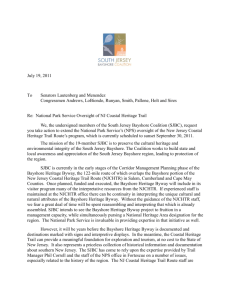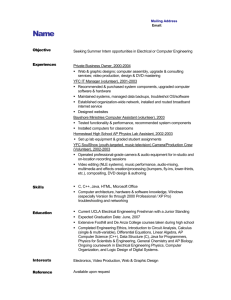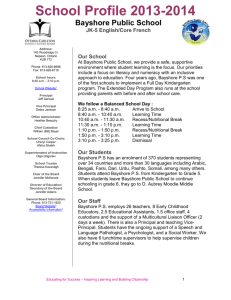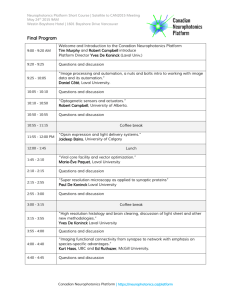Presentation
advertisement
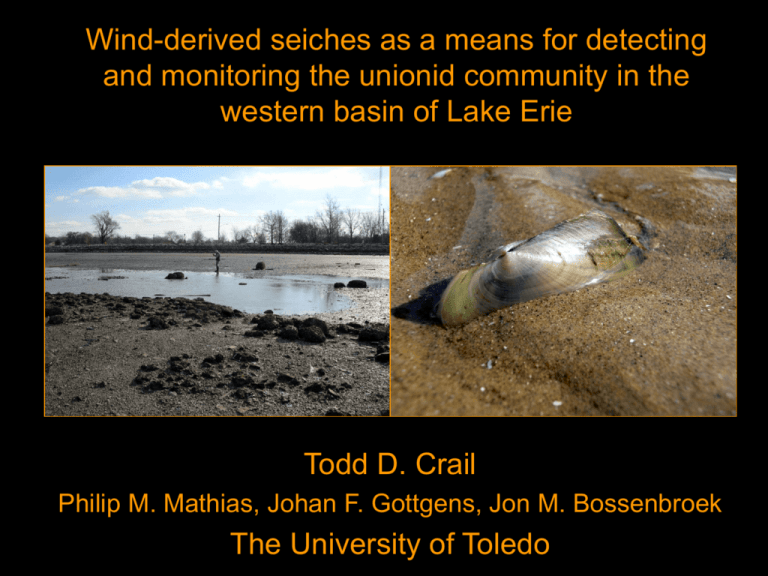
Wind-derived seiches as a means for detecting and monitoring the unionid community in the western basin of Lake Erie Todd D. Crail Philip M. Mathias, Johan F. Gottgens, Jon M. Bossenbroek The University of Toledo My Questions • Increasing number of refuges… • Are unionids found anywhere else, such as the in-shore marshes and near-shore open lake habitats? • Can I sample them? And how? • Richness? Recruitment? • Historic sequence in shell material? Sampling Sites N Lake Erie • Eight sites “qualitatively” sampled 2003-2008 Luna Pier • Sites open to lake, with dreissenids present Bayshore Maumee Bay SP Turtle Creek • Most sites also had diked marshes Ottawa NWR Toussaint Creek East Harbor Winous Point • Recovered live individuals of at least two species at all sites Sampling Sites – “Marshes” • First sites sampled were drowned river mouths and hemi-marsh • Methods were tactile and a modified basket rake • Timed searches, measured shell length, and classified as live, fresh dead, weathered and sub-fossil • Mobility increased greatly using snow shoes Sampling Sites – “Marshes” • Diked marshes had four species live – – – – Pyganodon grandis – Giant Floater Toxolasma parvus - Liliput Uniomerus tetralasumus – Pondhorn Utterbackia imbecillis – Pond Papershell • Open sites had up to seven species live – – – – – Leptodea fragilis - Fragile Papershell Lasmigona complanata - White Heelsplitter Potamilus alatus - Pink Heelsplitter Giant Floater Quadrula quadrula - Mapleleaf • Refer to Bowers & de Szalay 2004, American Midland Naturalist • Noticed the profound effect of seiches & how it simplified sampling Example Seiche (2003) 6 Displacement (feet) 4 2 0 -2 -4 -6 -8 Time (hours) http://en.wikipedia.org/wiki/Seiche Example Seiche – Bayshore Road (2006) One meter seiche during low water Example Seiche – Bayshore Road (2006) One meter seiche during low water Bayshore - 2006 • Four species recovered live – – – – • Amblema plicata – Threeridge Fragile Papershell Giant Floater Pink Heelsplitter In a 20 minute timed search, we found, measured, recorded and replaced 34 individuals (3 species) – Roughly 35 seconds per individual • In an additional 25 minute search, we found 5 live threeridge • Found 6 species fresh dead to lightly weathered • Found 3 species sub-fossil • The farther the seiche went out, the greater the abundance of live mussels Bayshore - 2006 • Fragile Papershell – 28 individuals – Length was 29 – 114 mm – Mean Length was 74 mm • Threeridge – 5 individuals – Length was 59 – 80 mm – Mean Length was 71 mm Bayshore - 2006 • Rate of dreissenid infection was < 10 dreissenids on any individual except (1) 109 mm fragile papershell (19) Partitioning of Habitat? RED – Fragile Papershell BLUE – Threeridge Green – Giant Floater Time Series 1955 1960 1965 Sub-Fossil 1970 1975 1980 Weathered 1985 1990 1995 2000 Fresh Dead More accurately account for time since death, since we can age live dreissenids inside the shell? 2006 Time Series 1955 1960 1965 1970 1975 1980 1985 1990 1995 2000 ? Sub-Fossil Weathered Fresh Dead Weathering is a spectrum depending on the system and species 2006 Time Series 1955 1960 1965 1970 1975 1980 1985 1990 1995 2000 ? ? ? ? Sub-Fossil ? Weathered Fresh Dead Fossilization is a spectrum process as well but… 2006 Time Series 1955 1960 1965 1970 1975 1980 1985 1990 1995 2000 ? ? ? Sub-Fossil ? ? Weathered Fresh Dead Fossilization is a spectrum process as well but… Why aren’t sub-fossil species found in the current assemblage? 2006 Time Series 1955 1960 1965 1970 1975 1980 1985 1990 1995 2000 ? ? ? Sub-Fossil ? ? Weathered Fresh Dead Fossilization is a spectrum process as well but… Why aren’t sub-fossil species found in the current assemblage? Why aren’t weathered, fresh dead & live species found in the sub-fossil assemblage? 2006 Winous Point Marsh Conservancy - 2006 • 6 species live (white heelsplitter, fragile papershell, pink heelsplitter, giant floater, lilliput, pond papershell) • 4 species fresh dead (threeridge, Obliquaria reflexa - threehorn wartyback, mapleleaf, pimpleback) Bayshore & Maumee Bay SP - 2008 • ~0.5 meter seiche event • At Bayshore Road – 32 individuals / 3 species – 28 were fragile papershell • mean length of 55 mm • mean length of 74 mm in 2006 • At Maumee Bay SP – 22 individuals / 2 species – 17 were fragile papershell • range 16 – 112 mm • mean length was 38 mm • mode was 29 mm – Continuous distribution – 6 weathered species More Partitioning of Habitat? RED – Fragile Papershell BLUE – Threeridge Green – Giant Floater More Partitioning of Habitat? RED – Fragile Papershell BLUE – Threeridge Green – Giant Floater YELLOW – Papershell, Floater and Pink Heelsplitter Juveniles! Is this evidence of ontogenic shifts? Or is it just a population sink? Bayshore - 2008 • (4) 100 meter transects with a modified BR-12 basket rake – www.shellfishing.com • No live species • Is the Missouri Trawl the answer? Substrates Higher Quality Substrate? Potamogeton crispus, Lyngbia sp. and Dreissenia building substrate deep enough for Unionids to burrow Higher Quality Substrate? 140 mm white heelsplitter in Dreissenid fortified fine silt (other Unionid species present as well) Ponar Sampling at Bayshore 2010 Our Ponar Rig Ponar Sampling at Bayshore 2010 Sediment Dry Mass from Bayshore Outlet to Maumee Bay State Park 700 R2 = 0.43 Sediment Dry Mass 600 500 400 300 200 100 0 0 5 10 15 Site Number 20 25 Ponar Sampling at Bayshore 2010 Sediment Dry Mass from Bayshore Outlet to Maumee Bay State Park 700 R2 = 0.43 Sediment Dry Mass 600 500 400 300 200 100 0 0 5 10 15 Site Number 20 25 Ponar Sampling at Bayshore 2010 Sediment Dry Mass from Bayshore Outlet to Maumee Bay State Park 700 R2 = 0.43 Sediment Dry Mass 600 500 400 300 200 100 0 0 5 10 15 Site Number 20 25 Ponar Sampling at Bayshore 2010 Sediment Dry Mass from Bayshore Outlet to Maumee Bay State Park 700 R2 = 0.43 Sediment Dry Mass 600 500 400 300 200 100 0 0 5 10 15 Site Number 20 25 Ponar Sampling at Bayshore 2010 Sediment Dry Mass from Bayshore Outlet to Maumee Bay State Park 700 R2 = 0.43 Sediment Dry Mass 600 500 400 300 200 100 0 0 5 10 15 Site Number 20 25 Ponar Sampling at Bayshore 2010 Ponar Sampling at Bayshore 2010 Site 2 Ponar Sampling at Bayshore 2010 Site 11 Ponar Sampling at Bayshore 2010 Site 18 Lake-Influenced Maumee River 2010 • Live fragile papershell, deertoe, threehorn wartyback, threeridge, mapleleaf, pimpleback, pink heelsplitter, white heelsplitter, giant floater, liliput, wabash pigtoe, fat mucket Lake-Influenced Maumee River 2010 • Live fragile papershell, deertoe, threehorn wartyback, threeridge, mapleleaf, pimpleback, pink heelsplitter, white heelsplitter, giant floater, liliput, wabash pigtoe, fat mucket X X XXX X X X Port Clinton 2010 • Fresh Dead shell from fragile papershell, giant floater, threeridge, white heelsplitter, pink heelsplitter, threehorn wartyback, deertoe and pond mussel on a public beach. Port Clinton 2010 • I hypothesize the success of the community has to do with sediment conveyance • This resolves fouling, food, and stability My Questions with Answers • Unionids are found elsewhere, such as the inshore marshes and near-shore open lake habitats. • I can sample them… with luck or hard work • There’s richness. There’s recruitment. • There’s an historic sequence in shell material, but it’s different at two times. More Questions Than Answers • What is the mechanism? • Veliger density dependent? Reduction of dreissenid health? Dreissenid predator density? Dreissenid air exposure? Or is it about substrate? • Or all of the above? Are there factors not considered? • Where else are they? And how can we find them? Acknowledgements • Fellowship with the National Science Foundation GK-12 Program DGE-0742395 • Funding from the Winous Point Marsh Conservancy • Lake Erie Center & Department of Environmental Sciences • Field help from Maria Tumeo • Thoughtful comments from Tom Bridgeman
